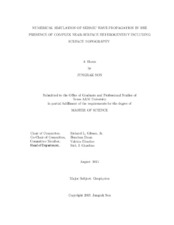| dc.description.abstract | Surface wave analysis and inversion have been developed to improve P-wave imaging for hydrocarbon reservoirs in land environments. This requires elastic wave modeling validation based on an accurate near-surface geology model. However, conventional modeling approaches with uniform grids pose significant challenges to represent complex geometry of near-surface heterogeneities and irregular surface topography. To solve this issue, numerical simulation of elastic wave propagation is implemented based on the spectral-element method, which is ideal for applying flexible unstructured grids. Locally-refined hybrid grids are used to describe the complex boundaries of subsurface structures, and refined grids are effective to reduce computational costs.
Three representative examples of geological features as near-surface heterogeneities are analyzed in seismic modeling with synthetic earth models. The structures are a shallow small scatterer, a collapsed karst structure and a low-velocity top layer with surface topography. The earth model geometry and material properties are based on the data from the recently released SEAM 2 project “arid model.” The resulting seismograms show that scattered surface waves from the shallow velocity anomalies are affected by the shape of modeling grids, properties of filling materials, attenuation, and curved surface topography. Specifically, the shallow scatterer, which is filled with low-velocity materials, shows a significant amount of trapped seismic energy and generates multiple scattered surface waves. These unwanted waves from trapped energy are strongly based on the surface topography and attenuation factor, Q. Since scattered surface waves are sensitively affected by various geological features and modeling factors, advanced seismic forward modeling approaches should be used for the accurate near-surface modeling. This study shows the capability and potential of the spectral-element method with advanced conforming grids to handle high impedance contrast boundaries for the analysis of interaction between the seismic wave scattering and complex heterogeneous shallow media. It will lead to improve distinguishing of seismic noise caused by shallow anomalies from the valuable signals associated with hydrocarbon reservoirs. | en |


